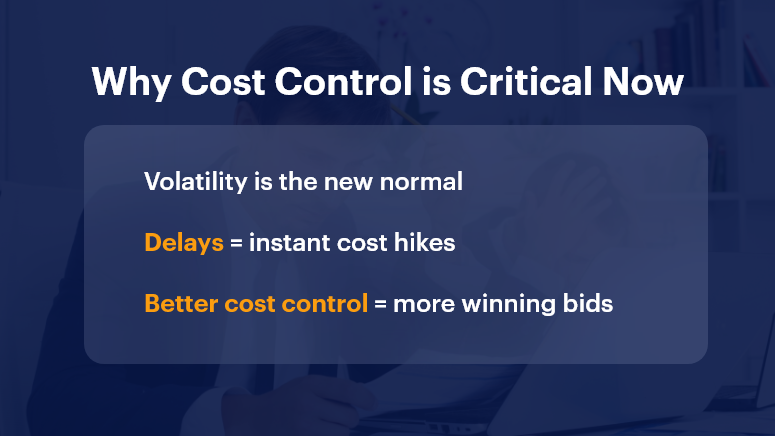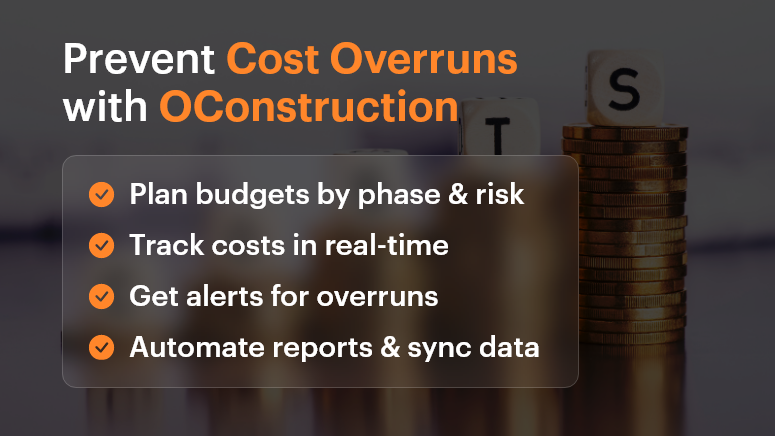In the past two years, construction material prices have surged by more than 40% in some categories, according to the U.S. Bureau of Labor Statistics. Lumber, steel, and concrete — the backbone of most builds — have been hit by unpredictable supply chain disruptions, fuel cost hikes, and global inflation.
For contractors, developers, and procurement managers, managing material costs in a volatile market is no longer just a financial concern — it’s a survival strategy. Without proactive cost control, projects can spiral over budget before the first concrete pour.
In this guide, we’ll explore the root causes of cost volatility, proven strategies to mitigate risks, and how OConstruction’s integrated platform empowers you to stay ahead — even when prices swing wildly.

Why Managing Material Costs in a Volatile Market Matters
Price instability can turn profitable projects into financial drains. When material costs rise unexpectedly, profit margins shrink, payment terms get tighter, and delivery schedules can collapse.
Why companies must act now:
- Market volatility is the new normal — Global supply chains remain fragile, and commodity prices are unpredictable.
- Small delays can cause big cost spikes — Postponed orders often face higher rates or rush premiums.
- Competition is fierce — Companies with better cost control win more bids.
Who benefits most from effective cost management?
- Project managers need accurate budget forecasting.
- Procurement teams are responsible for supplier negotiations.
- Executives safeguarding profitability.
Real-world pain points:
- Steel price jumps cause mid-project budget crises.
- Shipping container shortages delay material deliveries by weeks.
- Over-reliance on single suppliers leaves teams vulnerable to disruptions.
With OConstruction’s material cost tracking, supplier analytics, and forecasting tools, you can lock in pricing, spot risks early, and negotiate from a position of strength.
Best Practices for Managing Material Costs in a Volatile Market
1. Lock in Prices Early
Price guarantees and bulk purchasing agreements can protect against sudden cost hikes.
- Negotiate contracts with clear escalation clauses.
- Use OConstruction to track contract timelines and trigger renewal alerts before rates change.
2. Diversify Supplier Networks
Relying on a single source is risky in volatile markets.
- Maintain relationships with multiple vetted suppliers.
- Use supplier performance dashboards to compare delivery speed, reliability, and cost history.
3. Leverage Real-Time Data
Decisions made on outdated pricing data lead to overspending.
- Integrate live market feeds into procurement planning.
- OConstruction’s analytics help you spot trends before they impact your budget.
4. Optimize Inventory Management
Overstock ties up capital; understock causes delays.
- Use just-in-time ordering for predictable items.
- Employ demand forecasting features in OConstruction to balance supply and cash flow.
5. Standardize Materials Where Possible
Standardization simplifies procurement and increases bulk discount potential.
- Replace multiple similar products with a single approved option.
- Document standards in a central digital library accessible to all project teams.
6. Conduct Scenario Planning
Prepared teams can pivot faster when prices change.
- Run “what-if” simulations for cost increases or delivery delays.
- Align contingency plans with supplier capabilities.
7. Align Procurement and Project Schedules
When construction timelines and procurement aren’t in sync, costs climb.
- Use OConstruction to link project milestones with order placement deadlines.
- Avoid last-minute orders that attract premium pricing.
Customer Story: Turning Volatility into Opportunity
For example, Skyline Builders, a mid-sized commercial construction firm, faced soaring steel prices mid-way through a retail project. By using OConstruction’s supplier analytics and bulk procurement module, they acted fast:
- Locked in pricing for the remaining steel requirements.
- Shifted part of their order to a secondary supplier with surplus inventory.
- Monitored delivery schedules through the platform to avoid idle crews.
The result? They saved 12% on projected steel costs and delivered the project two weeks ahead of schedule — turning what could have been a budget disaster into a competitive win.
Key Takeaways
Managing material costs in a volatile market isn’t about eliminating risk — it’s about controlling it with data, foresight, and flexibility.
In summary:
- Act early — Secure prices before market swings.
- Stay flexible — Keep multiple suppliers and backup plans ready.
- Use data — Real-time insights beat guesswork.
By combining strategic procurement practices with OConstruction’s digital tools, you can safeguard budgets, strengthen supplier relationships, and keep projects moving despite market turbulence.
And remember — volatile markets reward the prepared, not the reactive.


